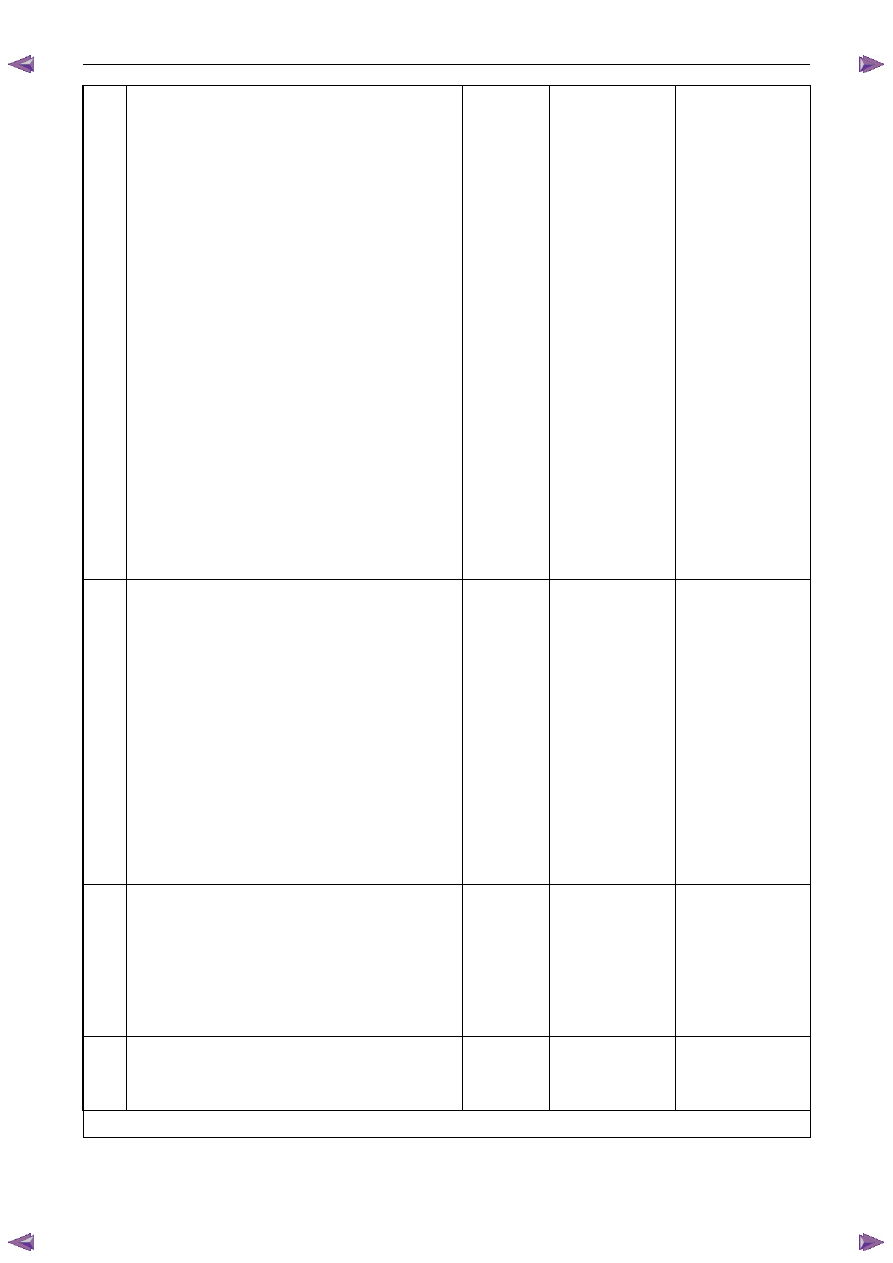Isuzu KB P190. Manual — part 866

Engine Management – V6 – Diagnostics
Page 6C1-2–186
2
N O T E
If any DTCs are set, except P2177 or
P2179, refer to those DTCs before
proceeding with this diagnostic.
1
Idle the engine at the normal operating
temperature.
2
Check that the fuel system is operating in Closed
Loop.
3
Observe the Total Fuel Trim Avg. parameter for
bank 1 or bank 2 with a scan tool.
Is the Total Fuel Trim Avg. less than the specified
value indicated?
23%
Go to Step 3
Go to Step 4
3
1
Use Tech 2 to clear the DTC/s.
2
Ignition OFF for 30 seconds.
3
Start the engine.
4
Operate the vehicle within the Conditions for
Running the DTC.
Does the DTC fail this ignition cycle?
—
Go to Step 4
Refer to Additional
Information in this
DTC
4
Are both banks of the engine operating lean?
—
Go to Step 5
Go to Step 7
5
1
Start the engine.
N O T E
Additional DTCs will set when the MAF
sensor disconnected.
2
Disconnect the mass air flow (MAF) sensor
harness connector while the engine is operating.
3
Observe the Short Term FT parameter for bank 1
and bank 2, using Tech 2.
4
Reconnect the MAF sensor after completing this
step.
Does the Short Term FT parameter for both banks of
the engine change more than the specified value with
the MAF sensor disconnected?
20%
Go to 7.6
DTC
P0101, P0102 or
P0103in this
Section
Go to Step 6

Engine Management – V6 – Diagnostics
Page 6C1-2–187
6
1
Inspect for the following conditions:
−
The vacuum hoses for splits, kinks, and
proper connections.
−
The throttle body and the intake manifold
for vacuum leaks.
−
The crankcase ventilation valve and system
for leaks.
−
The air intake system after the MAF sensor
for vacuum leaks.
−
Contaminated fuel. Refer to 6.5 Alcohol /
Contaminants in Fuel Diagnosis in this
Section.
−
Lean injectors – refer to 6.2
Fuel
Injector Coil Test in this Section.
−
The engine control ground points for being
clean, tight, and in the correct locations.
−
A high engine oil level condition. A high
engine oil level causes oil residue to form
on the mass air flow (MAF) sensor, causing
a lean indication. The MAF sensor does not
need to be replaced.
−
An engine mechanical condition.
Did you find and correct the condition?
—
Go to Step 8
Go to Additional
Information in this
DTC
7
1
Inspect for the following conditions:
−
Vacuum leaks that only affect one bank of
the engine--For example, the intake
manifold, the injector O-rings.
−
Lean injectors--Refer to 6.2
Fuel
Injector Coil Test in this Section.
−
Exhaust leaks, missing or loose exhaust
hardware. Refer to 6F Exhaust System –
V6.
−
The heated oxygen sensors (HO2S) are
installed securely and the electrical
connectors are not contacting the exhaust
system.
−
An engine mechanical condition.
Did you find and correct the condition?
—
Go to Step 8
Refer to Additional
Information in this
DTC
8
Using Tech 2, clear the DTCs.
2
Switch off the ignition for 30 seconds.
3
Start the engine.
4
Operate the vehicle within the conditions for
running the DTC.
Did DTC P2177 or P2179 fail this ignition cycle?
—
Go to Step 2
Go to Step 9
9
1
Using Tech 2, select the DTC display function.
Does Tech 2 display any DTCs?
—
Go to the
appropriate DTC
Table in this
Section System
OK
When all diagnosis and repairs are completed, clear all DTCs and verify correct operation
Engine Management – V6 – Diagnostics
Page 6C1-2–188
7.52 DTC P2178 or P2180
DTC Descriptors
This diagnostic procedure supports the following DTCs:
•
DTC P2178 Fuel Trim System Rich at Cruise or Accel Bank 1
•
DTC P2180 Fuel Trim System Rich at Cruise or Accel Bank 2
Circuit Description
The engine control module (ECM) controls the air / fuel metering system to provide the best possible combination of
driveability, fuel economy, and emission control. Fuel delivery is controlled differently during Open and Closed Loop.
During Open Loop, the ECM determines fuel delivery based on sensor signals without heated oxygen sensor (HO2S)
input. During Closed Loop, the HO2S inputs are added and used by the ECM to calculate short and long term fuel trim
fuel delivery adjustments. If the HO2S indicates a lean condition, fuel trim values will be above 0 percent. If the HO2S
indicates a rich condition, fuel trim values will be below 0 percent. Short term fuel trim values change rapidly in response
to the HO2S signals. Long term fuel trim makes coarse adjustments to maintain an air / fuel ratio of 14.7:1. If the ECM
detects an excessively rich condition, this DTC sets.
Conditions for Running the DTC
•
Before the ECM can report DTC P2178 or P2180 failed, DTCs P0101, P0121, P0122, P0123, P0133, P0153,
P0221, P0222, P0223, P0336, P0338, P0443, P0458, P0459, P0461, P0462, P0463, P2066, P2067, and P2068
must run and pass.
•
The fuel system is in closed loop.
•
The long fuel trim is active.
•
The engine coolant temperature (ECT) is more than 60° C.
•
The evaporative emission (EVAP) canister purge solenoid valve is not enabled.
•
The intake air temperature (IAT) is less than 60° C.
•
The fuel level is more than 11.6 percent.
•
The amount of air flow into the engine is more than 7,000 grams.
•
DTC P2178 and P2180 run continuously once the above conditions are met for at least 300 seconds.
Conditions for Setting the DTC
•
The Total Fuel Trim Avg. is less than –22 percent.
•
The condition exists for 4 seconds.
Action Taken When the DTC Sets
•
The control module illuminates the malfunction indicator lamp (MIL) on the second consecutive ignition cycle that
the diagnostic runs and fails.
•
The control module records the operating conditions at the time the diagnostic fails. The first time the diagnostic
fails, the control module stores this information in the Failure Records. If the diagnostic reports a failure on the
second consecutive ignition cycle, the control module records the operating conditions at the time of the failure.
The control module writes the operating conditions to the Freeze Frame and updates the Failure Records.
Conditions for Clearing the MIL/DTC
•
The Fuel Trim System circuit DTCs are Type ‘B’ DTCs. Refer to 1.4
Diagnostic Trouble Codes in this Section,
for action taken when a Type ‘B’ DTC sets and conditions for clearing Type ‘B’ DTCs.
•
Use Tech 2 to clear the MIL and the DTC.
Additional Information
•
A fuel delivery condition causes this DTC to set. Thoroughly inspect all items that could cause a rich condition.

Engine Management – V6 – Diagnostics
Page 6C1-2–189
•
For an intermittent fault condition, refer to 5.2
Intermittent Fault Conditions in this Section.
•
Since fault condition in a wiring connector may trigger DTCs, always test the connectors related to this diagnostic
procedure for shorted terminals or poor wiring connection before replacing any component. Refer to 8A Electrical -
Body and Chassis for information on electrical fault diagnosis.
•
To assist diagnosis, refer to 3
Wiring Diagrams and Connector Charts in this Section, for the system wiring
diagram and connector charts.
Test Description
The numbers below refer to the step numbers on the diagnostic table.
2
This step determines whether the fault is present.
4
If DTC P2178 and DTC P2180 set at the same time, then both banks of the engine are operating rich. Inspect
items that would cause both banks of the engine to operate rich.
5
Disconnecting the mass air flow (MAF) sensor determines if the MAF sensor signal is skewed. If the Short Term
FT parameter changes more than the specified value, there is a condition with the MAF sensor. A MAF sensor
condition can cause this DTC without setting a MAF DTC. If there is a MAF sensor condition, the MAF sensor
parameters will appear to be within range.
DTC P2178 or P2180 Diagnostic Table
Step Action Value(s)
Yes
No
1
Has the Diagnostic System Check been completed?
—
Go to Step 2
Refer to
4.4 Diagnostic
System Check in this
Section
2
N O T E
If any DTCs are set, except P2178 and
DTC P2180, refer to those DTCs before
proceeding with this diagnostic.
1
Idle the engine at the normal operating
temperature.
2
Check that the fuel system is in Closed Loop.
3
Observe the Total Fuel Trim Avg. parameter for
bank 1 and / or bank 2 with Tech 2.
Is the Total Fuel Trim Avg. less than the specified
value?
–22%
Go to Step 3
Go to Step 4
3
1
Observe the Freeze Frame and / or the Failure
records data for this DTC.
2
Turn the ignition OFF for 30 seconds.
3
Start the engine.
4
Operate the vehicle within the Conditions for
Running the DTC. You may also operate the
vehicle within the conditions that you observed
from the Freeze Frame and / or the Failure
records data.
Does the DTC fail this ignition cycle?
—
Go to Step 4
Refer to Additional
Information in this
DTC.
4
Are both banks of the engine operating rich?
—
Go to Step 5
Go to Step 7

Нет комментариевНе стесняйтесь поделиться с нами вашим ценным мнением.
Текст